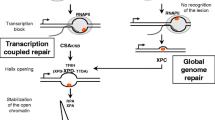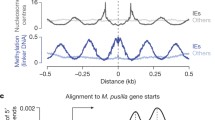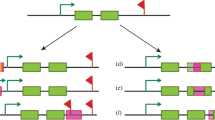Abstract
Nonrandom distributions of transposable elements can be generated by a variety of genomic features. Using the full D. melanogaster genome as a model, we characterize the orientations of different classes of transposable elements in relation to the directionality of genes. DNA-mediated transposable elements are more likely to be in the same orientation as neighboring genes when they occur in the nontranscribed region’s that flank genes. However, RNA-mediated transposable elements located in an intron are more often oriented in the direction opposite to that of the host gene. These orientation biases are strongest for genes with highly biased codon usage, probably reflecting the ability of such loci to respond to weak positive or negative selection. The leading hypothesis for selection against transposable elements in the coding orientation proposes that transcription termination poly(A) signal motifs within retroelements interfere with normal gene transcription. However, after accounting for differences in base composition between the strands, we find no evidence for global selection against spurious transcription termination signals in introns. We therefore conclude that premature termination of host gene transcription due to the presence of poly(A) signal motifs in retroelements might only partially explain strand-specific detrimental effects in the D. melanogaster genome.



Similar content being viewed by others
References
Akashi H (1994) Synonymous codon usage in Drosophila melanogaster: natural selection and translational accuracy. Genetics 136:927–935
Bartolome C, Maside X, Charlesworth B (2002) On the abundance and distribution of transposable elements in the genome of Drosophila melanogaster. Mol Biol Evol 19:926–937
Biemont C, Tsitrone A, Vieira C, Hoogland C (1997) Transposable element distribution in Drosophila. Genetics 147:1997–1999
Burge C, Campbell AM, Karlin S (1992) Over-representation and under-representation of short oligonucleotides in DNA-sequences. Proc Natl Acad Sci USA 89:1358–1362
Carr M, Soloway JR, Robinson TE, Brookfield JFY (2002) Mechanisms regulating the copy numbers of six LTR retrotransposons in the genome of Drosophila melanogaster. Chromosoma 110:511–518
Charlesworth B, Charlesworth D (1983) The population-dynamics of transposable elements. Genet Res 42:1–27
Charlesworth B, Langley CH (1989) The population-genetics of Drosophila transposable elements. Annu Rev Genet 23:251–287
Charlesworth B, Morgan MT, Charlesworth D (1993) The effect of deleterious mutations on neutral molecular variation. Genetics 134:1289–1303
Daborn PJ, Yen JL, Bogwitz MR et al (2002) A single P450 allele associated with insecticide resistance in Drosophila. Science 297:2253–2256
Dieringer D, Schlotterer C (2003) Two distinct modes of microsatellite mutation processes: Evidence from the complete genomic sequences of nine species. Genome Res 13:2242–2251
Duret L, Marais G, Biemont C (2000) Transposons but not retrotransposons are located preferentially in regions of high recombination rate in Caenorhabditis elegans. Genetics 156:1661–1669
Duret L, Mouchiroud D (1999) Expression pattern and, surprisingly, gene length shape codon usage in Caenorhabditis, Drosophila, Arabidopsis. Proc Natl Acad Sci USA 96:4482–4487
Errede B, Company M, Hutchison CA (1987) Ty1 sequence with enhancer and mating–type–dependent regulatory activities. Mol Cell Biol 7:258–265
Franchini LF, Ganko EW, McDonald JF (2004) Retrotransposon-gene associations are widespread among D. melanogaster populations. Mol Biol Evol 21:1323–1331
Girard L, Freeling M (1999) Regulatory changes as a consequence of transposon insertion. Dev Genet 25:291–296
Hey J, Kliman RM (2002) Interactions between natural selection, recombination and gene density in the genes of Drosophila. Genetics 160:595–608
Hill WG, Robertson A (1966) Effect of linkage on limits to artificial selection. Genet Res 8:269–294
Ikemura T (1985) Codon usage and transfer-RNA content in unicellular and multicellular organisms. Mol Biol Evol 2:13–34
Jakubczak JL, Burke WD, Eickbush TH (1991) Retrotransposable elements R1 and R2 interrupt the ribosomal-RNA genes of most insects. Proc Natl Acad Sci USA 88:3295–3299
Jiang YW (2002) Transcriptional cosuppression of yeast Ty1 retrotransposons. Genes & Development 16:467–478
Kaminker J, Bergman C, Kronmiller B, et al. (2002) The transposable elements of the Drosophila melanogaster euchromatin: a genomics perspective. Genome Biol 3:research0084.1–20
Kidwell MG, Lisch DR (2001) Perspective: Transposable elements, parasitic DNA, and genome evolution. Evolution 55:1–24
Kliman RM, Hey J (2003) Hill–Robertson interference in Drosophila melanogaster: reply to Marais, Mouchiroud and Duret. Genet Res 81:89–90
Kreitman M (1983) Nucleotide polymorphism at the alcohol-dehydrogenase locus of Drosophila melanogaster. Nature 304:412–417
Langley CH, Montgomery E, Hudson R, Kaplan N, Charlesworth B (1988) On the role of unequal exchange in the containment of transposable element copy number. Genet Res 52:223–235
Lerat E, Rizzon C, Biemont C (2003) Sequence divergence within transposable element families in the Drosophila melanogaster genome. Genome Res 13:1889–1896
Lerman DN, Michalak P, Helin AB, Bettencourt BR, Feder ME (2003) Modification of heat-shock gene expression in Drosophila melanogaster populations via transposable elements. Mol Biol Evol 20:135–144
Li W–H (1997) Molecular evolution. Sinauer, Sunderland, MA
Lynch M, Walsh JB (1997) Genetics and analysis of quantitative traits. Sinauer Associates, Sunderland, MA
Marais G, Mouchiroud D, Duret L (2001) Does recombination improve selection on codon usage? Lessons from nematode and fly complete genomes. Proc Natl Acad Sci USA 98:5688–5692
Marais G, Mouchiroud D, Duret L (2003) Neutral effect of recombination on base composition in Drosophila. Genet Res 81:79–87
Martin E, Laloux H, Couette G, Alvarez T, Bessou C, Hauser O, Sookhareea S, Labouesse M, Segalat L (2002) Identification of 1088 new transposon insertions of Caenorhabditis elegans: A pilot study toward large-scale screens. Genetics 162:521–524
McDonald JF, Matyunina LV, Wilson S, Jordan IK, Bowen NJ, Miller WJ (1997) LTR retrotransposons and the evolution of eukaryotic enhancers. Genetica 100:3–13
Medstrand P, van de Lagemaat LN, Mager DL (2002) Retroelement distributions in the human genome: Variations associated with age and proximity to genes. Genome Res 12:1483–1495
Montgomery E, Charlesworth B, Langley CH (1987) A test for the role of natural selection in the stabilization of transposable element copy number in a population of Drosophila melanogaster. Genet Res 49:31–41
Pardue ML, DeBaryshe PG (1999) Drosophila telomeres: two transposable elements with important roles in chromosomes. Genetica 107:189–196
Petrov DA, Lozovskaya ER, Hartl DL (1996) High intrinsic: Rate of DNA loss in Drosophila. Nature 384:346–349
Petrov DA, Hartl DL (1998) High rate of DNA loss in the Drosophila melanogaster and Drosophila virilis species groups. Mol Biol Evol 15:293–302
Petrov DA, Aminetzach YT, Davis JC, Bensasson D, Hirsh AE (2003) Size matters: Non-LTR retrotransposable elements and ectopic recombination in Drosophila. Mol Biol Evol 20:880–892
Rizzon C, Marais G, Gouy M, Biemont C (2002) Recombination rate and the distribution of transposable elements in the Drosophila melanogaster genome. Genome Res 12:400–407
Rizzon C, Martin E, Marais G, Duret L, Segalat L, Biemont C (2003) Patterns of selection against transposons, inferred from the distribution of Tc1, Tc3 and Tc5 insertions in the mut-7 line of the nematode Caenorhabditis elegans. Genetics 165:1127–1135
Schlenke TA, Begun DJ (2004) Strong selective sweep associated with a transposon insertion in Drosophila simulans. Proc Natl Acad Sci USA 101:1626–1631
Semon M, Duret L (2004) Evidence that functional transcription units cover at least half of the human genome. Trends Genet 20:229–232
Smit AFA (1999) Interspersed repeats and other mementos of transposable elements in mammalian genomes. Curr Opin Genet Dev 9:657–663
Sokal RR, Rohlf FJ (1995) Biometry. W.H. Freeman and Company, New York
Spradling AC, Stern DM, Kiss I, Roote J, Laverty T, Rubin GM (1995) Gene disruptions using P transposable elements: An integral component of the Drosophila genome project. Proc Natl Acad Sci USA 92:10824–10830
Stolc V, Gauhar Z, Mason C, et al. (2004) A gene expression map for the euchromatic genome of Drosophila melanogaster. Science 306:655–660
van de Lagemaat LN, Landry JR, Mager DL, Medstrand P (2003) Transposable elements in mammals promote regulatory variation and diversification of genes with specialized functions. Trends Genet 19:530–536
Waterston RH, Lindblad-Toh K, Birney E, et al. (2002) Initial sequencing and comparative analysis of the mouse genome. Nature 420:520–562
Wright SI, Agrawal N, Bureau TE (2003) Effects of recombination rate and gene density on transposable element distributions in Arabidopsis thaliana. Genome Res 13:1897–1903
Yu N, Jensen–Seaman MI, Chemnick L, Ryder O, Li W–H (2004) Nucleotide diversity in gorillas. Genetics 166:1375–1383
Zhao J, Hyman L, Moore C (1999) Formation of mRNA 3′ ends in eukaryotes: Mechanism, regulation, and interrelationships with other steps in mRNA synthesis. Microbiol Mol Biol Rev 63:405–445
Acknowledgments
We are grateful to H. Ochman for his critical advising and steadfast encouragement and to L. Duret for introducing us to the issue of TE orientation bias. We also thank the discussion and comments of the University of Arizona IGERT fellows, C. Bartolomé, B. Charlesworth, E. Lerat, D. Petrov, R. Reed, and several anonymous reviewers. This research was conducted as part of the University of Arizona NSF Integrative Graduate Education Research Training (IGERT) grant Genomics Initiative (DGE-0114420).
Author information
Authors and Affiliations
Corresponding author
Additional information
[Reviewing Editor : Dr. Dmitri Petrov]
Electronic Supplementary Material
Rights and permissions
About this article
Cite this article
Cutter, A.D., Good, J.M., Pappas, C.T. et al. Transposable Element Orientation Bias in the Drosophila melanogaster Genome. J Mol Evol 61, 733–741 (2005). https://doi.org/10.1007/s00239-004-0243-0
Received:
Accepted:
Published:
Issue Date:
DOI: https://doi.org/10.1007/s00239-004-0243-0




